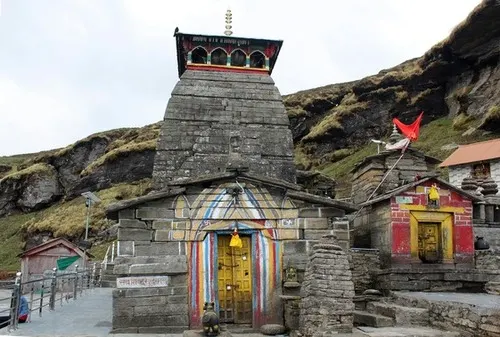Tungnath Temple, nestled in the Garhwal Himalayas of Uttarakhand, India, is a testament to the country’s rich cultural and spiritual heritage.
Context- Discussions have emerged regarding the conservation efforts for ancient sites like the Tungnath Temple and Edakkal Caves, emphasizing the need to protect India’s rich cultural heritage.
Unraveling the Mystical Geography of Tungnath
Location: Situated in the Rudraprayag district of Uttarakhand, India, Tungnath Temple resides in the Tungnath mountain range, which forms the Mandakini and Alaknanda river valleys.
Altitude: The temple is perched at an elevation of 3,680 meters (12,073 feet), making it one of the highest Shiva temples globally.
Surroundings: Located just below the Chandrashila peak, the area offers panoramic views of the Himalayan ranges, including peaks like Nanda Devi, Panch Chuli, Banderpoonch, Kedarnath, Chaukhamba, and Neelkanth.
A Walk Through History: Tungnath’s Mythological Significance
Mythological Significance: According to Hindu mythology, Tungnath is linked to the Pandavas from the epic Mahabharata. Seeking Lord Shiva’s forgiveness for their actions in the Kurukshetra war, the Pandavas embarked on a journey during which Shiva disguised himself as a bull to avoid them. It is believed that Tungnath is the place where the arms of the bull (a manifestation of Shiva) appeared.
Panch Kedar: Tungnath is the highest among the five Panch Kedar temples, which are Kedarnath, Tungnath, Rudranath, Madhyamaheshwar, and Kalpeshwar, all dedicated to Lord Shiva.
Ancient Architecture: The Unique Design of Tungnath Temple
Style: The temple showcases traditional North Indian architecture (Nagara Style) with a pyramid-shaped stone structure and a wooden mandapa (hall) adorned with intricate carvings of deities and mythological scenes.
Construction: Attributed to the Pandavas, the temple’s exact date of establishment remains uncertain, adding to its mystical allure.
Conservation and Preservation: Protecting India’s Heritage
Tourism and Trekking: Beyond its religious significance, Tungnath has become a popular destination for trekkers and nature enthusiasts, offering scenic trails and rich biodiversity.
Conservation Efforts: Recent discussions have highlighted the need to preserve Tungnath Temple, emphasizing the protection of India’s rich cultural heritage.
Renowned industrialist Mukesh Ambani has pledged assistance for the conservation and restoration of Tungnath Temple. During a visit to the region, he assured the Badri-Kedar Temple Committee of his commitment to support preservation efforts.
Fascinating Facts About Tungnath You Didn’t Know
Elevation: Tungnath Temple is one of the highest Shiva temples in the world.
Flora: The region around Tungnath is adorned with vibrant rhododendron forests, which bloom spectacularly in March, painting the landscape in hues of crimson and pink.
Wildlife Sanctuary: The nearby Kedarnath Wildlife Sanctuary, established in 1972, aims to protect the endangered musk deer native to this region.
If you found this helpful, you might also like these articles:
📌 [ https://upscmatters.com/unveiling-edakkal-caves-a-prehistoric-marvel/]
📌 [ https://upscmatters.com/indus-valley-civilization/]
They cover key concepts that will boost your preparation! 🚀
To enhance your understanding here are some external links of Tungnath Temple:
- Official Uttarakhand Tourism Website: Provides comprehensive information on Tungnath Temple, including travel details and nearby attractions.-https://uttarakhandtourism.gov.in/
- Wikimedia Commons: Access a repository of free-to-use images of Tungnath Temple and its surroundings.


1 thought on “Tungnath Temple: The Highest Shiva Shrine in the World”